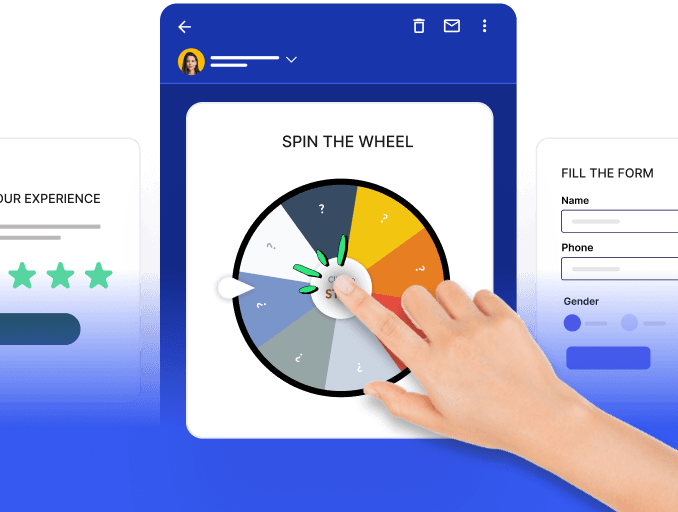Email marketing is the most effective way to build relationships with your recipients because it establishes a personal connection.
But, there are numerous challenges and obstacles that can hinder your email's success as it travels from the sender to the recipient's inbox. Despite your email getting delivered, there may be deliverability issues that may cause the email to land in spam.
As with airport security checks, email deliverability ensures that emails reach the recipient's inbox. While passengers and their belongings are safely navigated through airport security protocols and reached their destinations through airport security checks.
This guide is a deep dive into the common deliverability issues and how you can solve them.
Table of contents
What is email deliverability?
Email deliverability is an important metric that measures how many emails you sent landed in the end users’ inbox.
While email delivery measures how many emails got delivered, deliverability measures how many of them ended up in the inbox..
The average deliverability is 84.2%.
You can read this guide to get a deeper insight into Deliverability.
When it comes to email outreach, why is deliverability so important?
Similar to how a runner undergoes checks to ensure fair competition, your email goes through a spam filter checks from authentication to spam score of templates. Similarly, emails with proper authentication and favorable sender reputations are more likely to pass the spam filter successfully,thereby improving their chances of landing inbox placement.
However, obstacles such as incorrect addresses or content issues can delay or disqualify your email (going to spam or bouncing).
The goal of every marketer is to see his email make it to the recipient’s inbox.
By maintaining a reasonable deliverability rate, you can ensure that:
The emails that you send don’t get lost in the spam folder.
You maintain a good reputation with the ISPs.
You achieve the ultimate goal-conversion.
6 Deliverability Issues and how to solve them
1. Your campaigns suddenly start landing in spam.
The email marketing world is often at crossroads as unwanted emails battle for your attention. Not only do emails from spam senders make it to spam, but your business’s emails can also land in the spam.
That’s when you have to circle back and see for gaps in Infrastructure because that’s where setup begins.
- Infrastructure: IP reputation with Google & Microsoft can be measured by looking at Google Postmaster & SNDS.
If you see that your IP reputation has dipped, identify the root cause:
is it a shared IP-if it's a shared IP, identify which customer is responsible for the dip.
If it's a dedicated IP, check what content and data was targeted on the day of the dip.
This is because your ESP needs to keep a constant eye on your IP so it doesn’t get listed, which we do at Mailmodo quite consistently. This helps maintain a good and consistent IP reputation.
- End User Response:
Avoid Investing in 3rd party databases because buying an email list may make your job easier, but in hindsight, that’s not the case because your emails reach recipients who share zero affinity with the brand.
As spam traps are not filtered, cleaning pre-bought databases with a tool won't do much good.
Also, what happens to users who have uninstalled your app and share a reduced affinity with your brand?
Thus,keeping a tab on the end user response helps ensure deliverability.
- Content Reputation : Deliverability issues related to content exist beyond the word FREE or other specific phrases.
Let’s say your email campaign is on the receiving end of many spam complaints.
As a result, the text in the footer can be a phone number or your email id gets cached negatively, causing it to land in spam even when you send it to the right audience segment from a different infrastructure.
The above is one of many instances that has a profound impact on the content's reputation. Following best practices such as eliminating URL shorteners like /bit.ly, and avoiding map tags, sometimes it’s better to prevent alt and title tags as they don’t impact emails in contrast to how they impact SEOs.
2.Sudden delivery errors
To determine delivery errors, you can use Google's Postmaster. Most of the common reasons include:
Temporary rate limits have been triggered because this domain or IP address has been sending traffic at an unusually high rate.
The incoming traffic is suspected to be spam.
The incoming email could be spam due to problems with the content.
Attachments in emails that are not authorized by the ISP.
DMARC policy of the sender’s domain doesn’t align with the recipient.
The domain & IP reputation of the sender is poor.
Using postmaster you not only identify the errors but also how it significantly hampers your deliverability. You can start by following these best practices,
Format emails as per internet standards.
Don’t send messages without seeking consent, as there’s a possibility that the recipient will mark you spam in the future.
Build on increasing your sending volume slowly.
Verify the sending server’s PTR(pointer) record.
3. Sudden dip in reputation
Let’s say most of your email list comprises gmails’s email addresses. So By using Postmaster, we can analyze the root cause behind the dip in reputation.
Because, a dip in reputation is caused by various factors, including:
Have you stopped signing authentication?
Have you changed the content?
Are you experiencing high spam complaints because you have changed the target audience
This is because adhering to authentication protocols shows email providers that you
have taken all the steps to secure your email systems and demonstrate that you are indeed who you intend to be.
💡 Related guide: Understanding Email Authentication Protocols: SPF, DKIM, and DMARC
From postmaster’s dashboard you can gauge the number of emails that have passed the authentication checks through a graph. If there’s any discrepancy, you can see that your authentication sits at 0%. This is the call to fix your authentication problems.
Also, content is not just the copy but also the subject line, header, design, and use of qualified domain names instead of shortened links.Through unsecured HTTP websites, spammers introduce Trojans and worms and try to hijack websites, and you should switch to a more secure HTTP as it’s encrypted.
4. IP gets blacklisted
Suppose, let’s say, you've been working hard for weeks on crafting the perfect email, and now the results are showing. You're seeing an increase in deliverability rates. Upon reviewing the statistics in your email marketing platform, disappointment washes over you as you observe your deliverability rates plummeting.
This is because there’s an increased chance of your emails getting blacklisted.This can be classified into
Real-time blacklists
Domain name server blacklists.
To find out whether you are on the blacklist, go to Mxtoolbox.It’s very easy to check by using the following steps:
Go to the official service page.
Enter your IP or domain address.
Press Check Blacklist.
Common reasons as to why your IP address is blacklisted can be due to various reasons:
At a minimum, emails have not been authenticated with DKIM & SPF.
If you keep sending emails to inactive email addresses, even the best emails will end up in the spam folder sooner rather than later.
Sending volumes are high - spammers send as many emails as they can, so you should monitor your sending volumes to avoid triggering blacklist suspicions. Keep the issue at bay by reconsidering your sending frequency.
Some users will always complain about spam, and there is little that can be done about it. If your spam complaint rate continues to rise, you must find the root cause and fix it.
💡 Related guide: How Does IP Address Affect Your Email Deliverability
5. ISPs get blocked by emails
The ISPs take many factors into account, and if you are found sending spam emails, most ISP will stop you from sending emails. In most cases, ISP gets blocked because of a local policy on the recipient's email server or, in rare cases, because of a reputation issue with the IP address used to send the message.
Also, they'll block you if you send email blasts without personalization, while having a bad domain and IP reputation will let ISPs block your emails.
For instance, if you have used Outlook, you must know that most legitimate emails are mistakenly blocked as threats(false positives).To avoid this, you can request recipients to mark your email as “not junk “ in addition to adding you to their safe sender list.Also, security administrators enable end users to receive an email digest about quarantined messages.
The key to success in email marketing is discipline. Sending messages in a timely and consistent manner requires a well-planned email cadence. Following best practices and good email etiquette will help you improve your IP and domain reputation and keep your ISPs from blocking you.
💡 Related guide: How Does IP Address Affect Your Email Deliverability
6. Bounces due to authentication errors
Authentication-related bounces occur when the recipient's mailbox does not accept an email. It is commonly said that “your email bounced.” Bounces are of two types: Hard and soft bounce. And bounces are majorly caused by authentication errors.
There are several reasons as to why authentication errors can cause bounces:
It is possible that the recipient's email address does not exist or needs to be corrected, resulting in a rejection. With double-opt-in signups, you eliminate the possibility of receiving misspelled or nonexistent email addresses.
A soft bounce occurs when the recipient's mailbox is full, and the storage limit has been exceeded. The email server will reject new messages until space is freed up. The recipient must make room for new ones in such cases.
The email may be rejected if the sender's domain is not authenticated. Some email servers require proper domain authentication (e.g., SPF, DKIM, DMARC).
The recipient's email server can block emails from specific sources using endpoint protection services, resulting in bounces. This can be addressed by enabling Branded URLs or authenticating the sending domain.
Takeaways
Email deliverability is a critical component of email marketing, as it determines whether emails get delivered to the recipient's inboxes rather than being flagged as spam. Maintaining a reasonable deliverability rate starts with addressing deliverability issues, as it helps keep up your domain & IP reputation and foster better engagement with your audience. Incorporate these best practices and taste the success of your email marketing campaigns.
What you should do next
Hey there, thanks for reading till the end. Here are 3 ways we can help you grow your business:
Talk to an email expert. Need someone to take your email marketing to the next level? Mailmodo’s experts are here for you. Schedule a 30-minute email consultation. Don’t worry, it’s on the house. Book a meet here.
Send emails that bring higher conversions. Mailmodo is an ESP that helps you to create and send app-like interactive emails with forms, carts, calendars, games, and other widgets for higher conversions. Get started for free.
Check out our AI prompts library. If you need AI prompts for ChatGPT or Bing, here's a ready-made database we’ve built to help marketers succeed at prompt engineering. Get your AI prompts here.
Get smarter with our email resources. Explore all our knowledge base here and learn about email marketing, marketing strategies, best practices, growth hacks, case studies, templates, and more. Access guides here.







